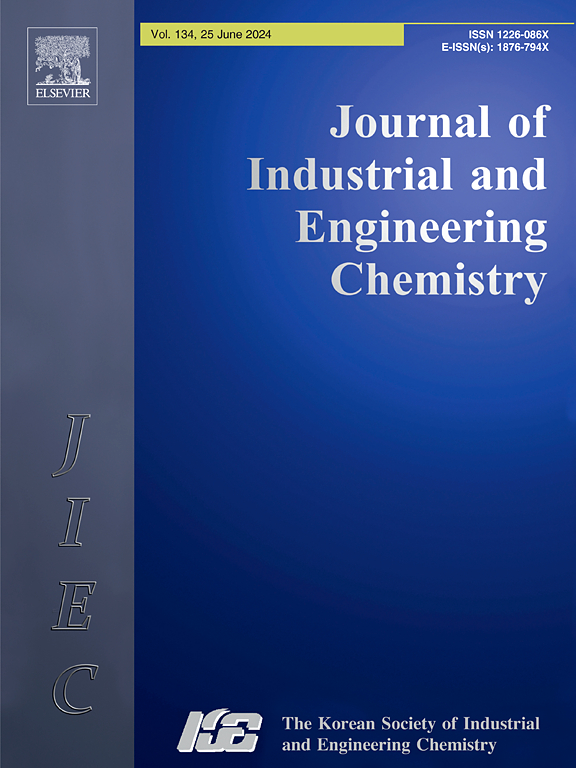Enhanced peroxi-coagulation process for the treatment of anaerobically-treated palm oil mill effluent (POME)
IF 5.9
3区 工程技术
Q1 CHEMISTRY, MULTIDISCIPLINARY
Journal of Industrial and Engineering Chemistry
Pub Date : 2025-02-21
DOI:10.1016/j.jiec.2025.02.045
引用次数: 0
Abstract
This study investigated the effectiveness of the peroxi-coagulation (PC) process in removing dissolved organic impurities from palm oil mill effluent (POME). Key experimental parameters assessed in this study included wastewater pH, electrolysis duration, and the dosage of H2O2. After a five-hour treatment period, maximum breakdown of organic contaminants and removal of suspended particles were achieved, with around 86 % of soluble COD (SCOD), 91 % of total COD (TCOD), 99 % of true colour, and 84 % of turbidity were removed under optimal operating conditions (pH 3 and external dosing of 31.09 mM H2O2). These outcomes can be attributed to two removal mechanisms: the predominant Fenton oxidation reaction at low pH which promoted effective •OH generation from the dosed H2O2, and the simultaneous coagulation activity by the electrochemically produced Fe(OH)3 coagulant. This PC process was governed by the pseudo-first-order kinetic model, which achieved a maximum kinetic rate of 0.5321 min−1 under ideal operating conditions. The estimated energy consumption for POME degradation ranged from 0.461 to 1.874 kWh per kg of COD reduced, indicating low electrical energy intake. These findings demonstrate the potential of the PC process as a pre- or post- treatment step that can enhance the removal of COD and pigmentation in integrated POME treatment systems.

强化过氧混凝工艺处理棕榈油厂厌氧废水
研究了过氧化混凝(PC)工艺去除棕榈油厂废水(POME)中溶解性有机杂质的效果。本研究评估的关键实验参数包括废水pH、电解时间和H2O2用量。经过5个小时的处理,有机污染物的最大分解和悬浮颗粒的去除达到了最大限度,在最佳操作条件下(pH 3和外部添加31.09 mM H2O2),约86%的可溶性COD (SCOD), 91%的总COD (TCOD), 99%的真色度和84%的浑浊度被去除。这些结果可归因于两种去除机制:低pH下主要的Fenton氧化反应促进了添加的H2O2有效生成•OH,以及电化学生成的Fe(OH)3混凝剂同时具有混凝活性。该过程由准一级动力学模型控制,在理想操作条件下,最大动力学速率为0.5321 min−1。POME降解的估计能耗范围为每千克COD减少0.461至1.874千瓦时,表明电能摄入较低。这些发现证明了PC工艺作为预处理或后处理步骤的潜力,可以增强综合POME处理系统中COD和色素沉着的去除。
本文章由计算机程序翻译,如有差异,请以英文原文为准。
求助全文
约1分钟内获得全文
求助全文
来源期刊
CiteScore
10.40
自引率
6.60%
发文量
639
审稿时长
29 days
期刊介绍:
Journal of Industrial and Engineering Chemistry is published monthly in English by the Korean Society of Industrial and Engineering Chemistry. JIEC brings together multidisciplinary interests in one journal and is to disseminate information on all aspects of research and development in industrial and engineering chemistry. Contributions in the form of research articles, short communications, notes and reviews are considered for publication. The editors welcome original contributions that have not been and are not to be published elsewhere. Instruction to authors and a manuscript submissions form are printed at the end of each issue. Bulk reprints of individual articles can be ordered. This publication is partially supported by Korea Research Foundation and the Korean Federation of Science and Technology Societies.

 求助内容:
求助内容: 应助结果提醒方式:
应助结果提醒方式:


